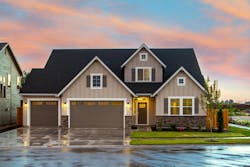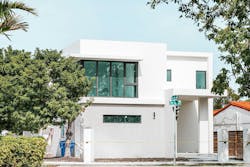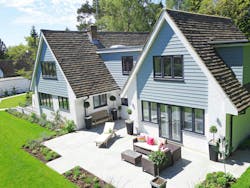Emerging trends in exterior design reflect larger societal shifts. As the nation changes, so do its homes. The rising interest in more energy-efficient houses, the pandemic-era popularity of embracing the outdoors, and the movement of people to the South and West are all factors that are reflected in the latest directions in exterior housing design and materials.
House Exterior Design Trends for 2021
Here are five modern home exterior design trends to watch out for in 2021, according to Tim Seims, director of building product intelligence, John Burns Real Estate Consulting.
1. Building science dictates home exterior design trends
Building science is having a clear effect on the kinds of exterior materials used. As builders strive to construct homes with better energy efficiency and improved indoor air quality, they have to carefully consider the material makeup of their building envelopes.
For instance, to allow greater airflow and prevent moisture, builders are separating the main structure from the cladding and roofing, moving the dew point away from the house. Builders might achieve that separation by using rainscreen siding or a cold roof assembly. But the stucco that used to be more common in states like Arizona and Florida won’t be as appealing, since stucco is applied directly to the structure.
“More and more, the look of a building is driven by its performance,” Seims says.
2. Builders are mixing and matching exterior materials to make their homes stand out
Historically, a residential neighborhood would have just one type of siding, whether it was lap, shingle, or board and batten siding. That’s been changing, Seims says. “We’re seeing a lot of mixing of materials.”
Rather than the tradition of one home, one exterior type, architects and builders are applying a few exterior materials to a single home. They’re drawing from a range of options: stone panels, fiber cement, wood shingles, and metals like aluminum and steel. The latest trend has been to have at least three different exterior materials on a single structure, Seims notes.
But there’s a method to putting various materials on the same house. Heavier-looking materials, such as brick, concrete, or stone panels, should line the first floor—creating a sense of a sturdy foundation. “It gives weight to the design,” Seims says. The higher floors should get materials that look and feel less heavy, like lap or wood siding.
By using different combinations of materials, you can adjust the home’s look and personality. “You can achieve both context and contrast,” Seims says. To create a strong sense of context and cohesion with the neighborhood, use at least one exterior material found in the surrounding properties. To create a greater sense of contrast, use at least one material that’s not seen nearby. “It gives the house character without standing out like a sore thumb.”
RELATED: Top 10 Outdoor Amenities at Multifamily Housing Developments for 2021
3. Modern exterior design is taken hold in new home construction
Residential homes are once again embracing the modern aesthetic, Seims says. That’s in part because modern architecture can accommodate different exterior materials—as opposed to contemporary designs that are more fixed in their looks.
And unlike contemporary or other era-bound designs, modern home exterior design trends have a longer-lasting appeal. A contemporary home, by contrast, retains its timestamp long after its time has passed (think ’70s ranch). “‘Modern’ is a misnomer because its popularity holds, even though everyone acts like they just discovered it,” Seims says.
Modern design also means more low-slope roofs and fewer traditional pitched gable roofs. What’s made low roofs more feasible is a commercial-grade membrane that’s tough enough to withstand foot traffic and rooftop decks. “So why not use the space for entertaining or relaxing?” Seims says.
Which leads to the next home exterior design trend.
4. Home buyers want to bring the outside in
With the pandemic keeping more people at home, homeowners want to make the most of their outdoor spaces. That’s informing how builders connect the outside to the inside.
For instance, instead of just a sliding patio door, builders are also installing entire walls that slide open—bringing the outside in, and vice versa. They’re also using materials, such as brick or concrete, that work in both exterior and interior spaces, tying the two together. “We used to see this more in the Sun Belt. Now we see it everywhere,” Seims says.
5. Modern home exterior design trends cross state lines
When people move, they take their aesthetic preferences with them. As more Americans migrate to the South and West, one thing they unwittingly pack is their design sense. They then bring those design expectations to the houses they buy or build.
For example, while the Southwest has been more of a stucco or vinyl siding market, people have been moving there from their cladding houses on the coasts—and that’s what they look for in their new places of residence.
“Just like people took votes with them to different states, they’re bringing their design preferences with them,” Seims says.


